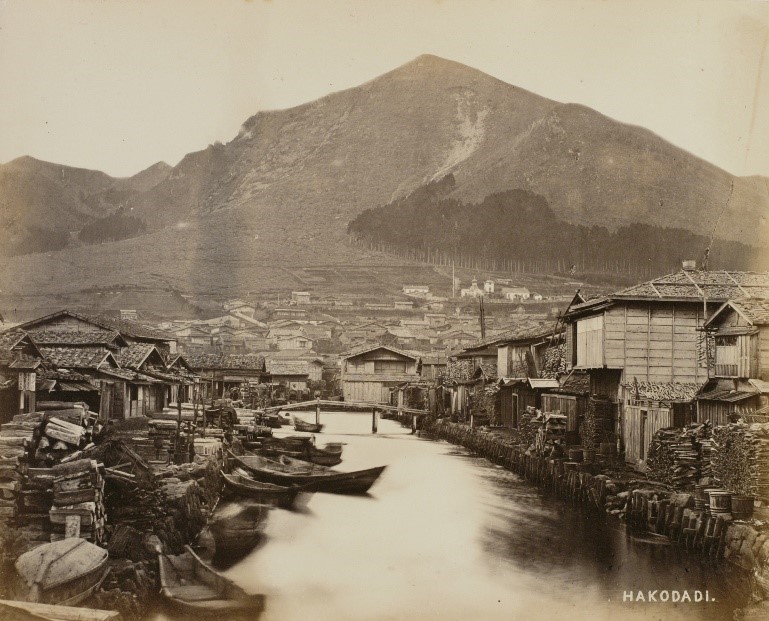
Baron Raimund von Stillfried, "HAKODADI", 1872, Albumen print, Tokyo Photographic Art Museum
The Tokyo Photographic Art Museum will adhere to relevant guidelines and take necessary measures to prevent the spread of the novel coronavirus. We ask for your understanding regarding inconveniences for this time. [Notices to Visitors]
3F
Geneses of Photography in Japan: Hakodate
Mar. 2—May. 8, 2022
- Mar. 2—May. 8, 2022
- Closed Mondays (except Mar. 21 and May 2), and Mar. 22
- Admission:Adults ¥700 / College Students ¥560 / High School and Junior High School Students, Over 65 ¥350. *Admission is free for grade school children or younger; junior high school students living or attending schools in the Tokyo metropolitan area, holders of Japan’s disability identification cards (shogaisha techo) together with two caregiver, and holders of the museum’s annual passport.
It is recommended that you use the online ticket system (timed entry reservation.)
Exhibition Summary
The Tokyo Photographic Art Museum’s series of exhibitions about early photography began in 2007. As the second in our 'Genesis of Photography in Japan' series, which addresses the places at which photography entered Japan, we are proud to present 'Genesis of Photography in Japan: Hakodate'.
This exhibition was planned under the supervision of Ohtsuka Kazuyoshi (Professor Emeritus, National Museum of Ethnology) and Takahashi Norihide (Professor, Department of Photography, College of Art, Nihon University). It consists of three sections in which we present early photographs of Hakodate and related materials. Hakodate, a major port in Japan’s north, experienced much upheaval, including a change in name, over the more than half a century from Bakumatsu, the closing years of the Tokugawa shogunate (c. 1850-1868), through the Meiji period (1868-1912).
When the shogunate and the Edo period ended in the mid-nineteenth century, Japan redirected itself to becoming a modern state that incorporated Western culture. Hakodate, which had been the northernmost port city controlled by the shogunate, took on a significant governmental role in gaining control of Ezo (now Hokkaido), suppressing conflicts, and engaging in foreign relations. When the port was opened to foreign trade in 1859, technologies introduced by Russians became the starting point for a flourishing culture of photography.
Section 1 presents the history of Hakodate from the Bakumatsu through the early Meiji period (c.1850-1880) in photographs and related materials. Section 2 focuses on the photographers. It introduces the photographers who captured images of Hakodate and the photographic techniques in use at that time. The final section presents the streets of Hakodate as the city went through the transition from Bakumatsu to Meiji, through original prints of early photographs, including panoramic photographs being displayed for the first time.
The places where photography originated in Japan have acquired, over their long connection to photography, vast accumulations of photographs. This series focuses primarily on photography’s early period and its context. It thus provides a valuable opportunity to reconstruct the transition of the culture of this northern port city from the early modern to the modern period through early photographs.
[Exhibition's Catalogue]
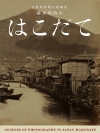
B5/144P/2,530yen The Tokyo Photographic Art Museum’s series of exhibitions about early photography began in 2007. As the second in our 'Genesis of Photography in Japan' series, which addresses the places at which photography entered Japan, we are proud to present 'Genesis of Photography in Japan: Hakodate'.
This exhibition was planned under the supervision of Ohtsuka Kazuyoshi (Professor Emeritus, National Museum of Ethnology) and Takahashi Norihide (Professor, Department of Photography, College of Art, Nihon University). It consists of three sections in which we present early photographs of Hakodate and related materials. Hakodate, a major port in Japan’s north, experienced much upheaval, including a change in name, over the more than half a century from Bakumatsu, the closing years of the Tokugawa shogunate (c. 1850-1868), through the Meiji period (1868-1912).
When the shogunate and the Edo period ended in the mid-nineteenth century, Japan redirected itself to becoming a modern state that incorporated Western culture. Hakodate, which had been the northernmost port city controlled by the shogunate, took on a significant governmental role in gaining control of Ezo (now Hokkaido), suppressing conflicts, and engaging in foreign relations. When the port was opened to foreign trade in 1859, technologies introduced by Russians became the starting point for a flourishing culture of photography.
Section 1 presents the history of Hakodate from the Bakumatsu through the early Meiji period (c.1850-1880) in photographs and related materials. Section 2 focuses on the photographers. It introduces the photographers who captured images of Hakodate and the photographic techniques in use at that time. The final section presents the streets of Hakodate as the city went through the transition from Bakumatsu to Meiji, through original prints of early photographs, including panoramic photographs being displayed for the first time.
The places where photography originated in Japan have acquired, over their long connection to photography, vast accumulations of photographs. This series focuses primarily on photography’s early period and its context. It thus provides a valuable opportunity to reconstruct the transition of the culture of this northern port city from the early modern to the modern period through early photographs.
[Exhibition's Catalogue]

Text by Ohtsuka Kazuyoshi (Professor Emeritus, National Museum of Ethnology), Takahashi Norihide (Professor, Department of Photography, College of Art, Nihon University), Oshita Tomokazu (Hokkaido Museum of Modern Art), Okuno Susumu (Hakodate City Museum), Mitsui Keishi (Tokyo Metropolitan Foundation for History and Culture)
*Text in English available via the link
Section 1. Hakodate History
Human beings began settling permanently in what is now Hokkaido about 30,000 years ago. Over time, in addition to hunting and fishing, the people of Hokkaido began trading extensively in local resources with commercial potential, particularly furs and seafood. By about the thirteenth century, Ainu culture, the culture of the people residing on the island, had developed in what is now seen as its traditional form. By the seventeenth and eighteenth century, wajin traders (Japanese from the main Japanese islands) were visiting the island in search of trade goods. That led to wajin beginning to reside there permanently.
Hakodate flourished in the Edo period (1600 –1868) as part of the Matsumae domain, as an important port, along with Matsumae and Esashi. In 1802, the Ezo Magistrate’s Office (later the Hakodate Magistrate’s Office) was established there; it served as the central base for the shogunate’s fforts to govern the island directly. In the Bakumatsu and Meiji periods, having become an open port, Hakodate had consulates representing many countries, among whom Russia was central. It received strong influences from European and American culture.
The Battle of Hakodate was the last battle of the Boshin War, the war between the supporters of the shogunate and those working for a new form of government, with the restoration of imperial power. In 1869, after the Meiji Restoration, the island of Ezo was renamed Hokkaido and Hakodate’s name received a change in the kanji characters used for it (from箱館 to 函館, both pronounced “Hakodate”). In 1871, with the establishment of the headquarters of the Development Commission in Sapporo, the administrative center of Hokkaido shifted there. Hakodate, however, continued to develop as a port city and as a base for northern-sea fisheries.
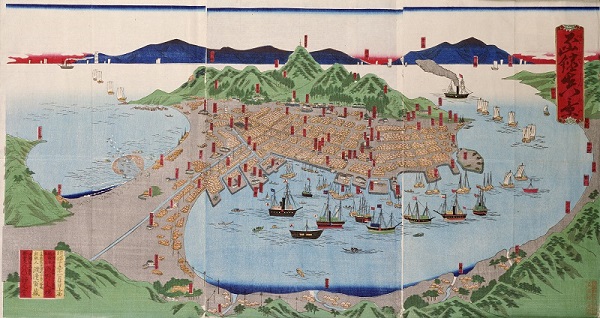
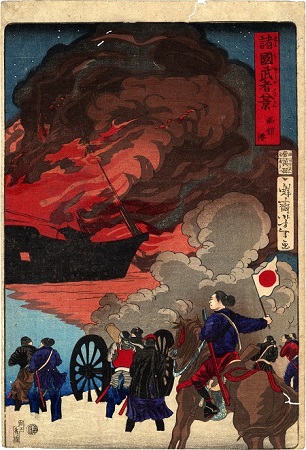 Tsukioka Yoshitoshi, "Eight Views of Warriors from Various Nations: Port of Hakodate", 1871, Polychrome woodblock print, Hakodate City Central Library
Tsukioka Yoshitoshi, "Eight Views of Warriors from Various Nations: Port of Hakodate", 1871, Polychrome woodblock print, Hakodate City Central Library
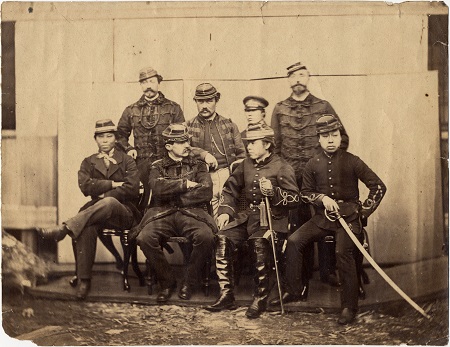 Tamoto Kenzo ?, "French Army Officer and Former Shogunate Army Officer", 1868 – 1869, Albumen print, Hakodate City Central Library
Tamoto Kenzo ?, "French Army Officer and Former Shogunate Army Officer", 1868 – 1869, Albumen print, Hakodate City Central Library
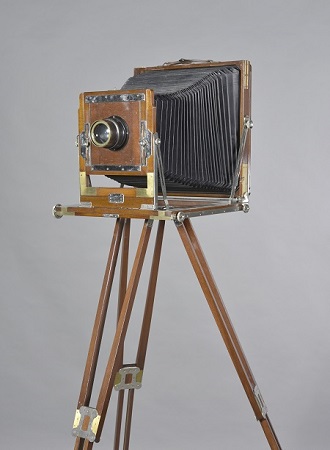 10×12 inch field camera, Nihon University, College of Art
10×12 inch field camera, Nihon University, College of Art

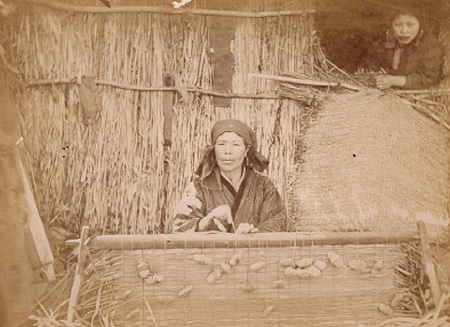
Human beings began settling permanently in what is now Hokkaido about 30,000 years ago. Over time, in addition to hunting and fishing, the people of Hokkaido began trading extensively in local resources with commercial potential, particularly furs and seafood. By about the thirteenth century, Ainu culture, the culture of the people residing on the island, had developed in what is now seen as its traditional form. By the seventeenth and eighteenth century, wajin traders (Japanese from the main Japanese islands) were visiting the island in search of trade goods. That led to wajin beginning to reside there permanently.
Hakodate flourished in the Edo period (1600 –1868) as part of the Matsumae domain, as an important port, along with Matsumae and Esashi. In 1802, the Ezo Magistrate’s Office (later the Hakodate Magistrate’s Office) was established there; it served as the central base for the shogunate’s fforts to govern the island directly. In the Bakumatsu and Meiji periods, having become an open port, Hakodate had consulates representing many countries, among whom Russia was central. It received strong influences from European and American culture.
The Battle of Hakodate was the last battle of the Boshin War, the war between the supporters of the shogunate and those working for a new form of government, with the restoration of imperial power. In 1869, after the Meiji Restoration, the island of Ezo was renamed Hokkaido and Hakodate’s name received a change in the kanji characters used for it (from箱館 to 函館, both pronounced “Hakodate”). In 1871, with the establishment of the headquarters of the Development Commission in Sapporo, the administrative center of Hokkaido shifted there. Hakodate, however, continued to develop as a port city and as a base for northern-sea fisheries.

Asano Fumiteru, "True View of Hakodate", 1882, Polychrome woodblock print, Hakodate City Central Library


Section 2. The Photographers Who Captured Hakodate and the Mechanics of Early Photography
Hakodate is one of places where photography originated in Japan. The foundations of the history of photography in Japan were laid there during the political transitions from the early modern period (the Tokugawa shogunate) to the modern Meiji state.
This section introduces seven photographers with ties to Hakodate. They include photographers who would establish commercial photography studios there, such as Tamoto Kenzo, who learned the techniques of photography from a Russian, and Takebayashi Seiichi, who had been assigned to serve the Development Commission as a photographer. Other notable Hakodate connections include Noguchi Gennosuke, who took photographs while visiting the area on official duty, and the Yokohama-based Austrian photographer Raimund von Stillfried, who was invited to visit by the Development Commission.
Photographic technology is also a focus of this section. Through cameras, tripods, negative plates, and other historic materials, it introduces that early technology, so different from ours today, particularly in the production of both negatives and prints.
Hakodate is one of places where photography originated in Japan. The foundations of the history of photography in Japan were laid there during the political transitions from the early modern period (the Tokugawa shogunate) to the modern Meiji state.
This section introduces seven photographers with ties to Hakodate. They include photographers who would establish commercial photography studios there, such as Tamoto Kenzo, who learned the techniques of photography from a Russian, and Takebayashi Seiichi, who had been assigned to serve the Development Commission as a photographer. Other notable Hakodate connections include Noguchi Gennosuke, who took photographs while visiting the area on official duty, and the Yokohama-based Austrian photographer Raimund von Stillfried, who was invited to visit by the Development Commission.
Photographic technology is also a focus of this section. Through cameras, tripods, negative plates, and other historic materials, it introduces that early technology, so different from ours today, particularly in the production of both negatives and prints.

Section 3. Bird’s Eye Views of Hakodate
Even after the headquarters of the Development Commission were moved to Sapporo, Hakodate continued to be the gateway through which people and goods reached Hokkaido. It steadily developed as Hokkaido’s most important port city, especially given that it was the closest to Honshu, the main Japanese island just south of it. Major fires in 1878 and 1879 forced transformations from the Edo period cityscape. In the 1880 and 1890s, the construction of a waterworks supplying water to the city and the reclamation of what had been the Benten Daiba fortress were among the projects to improve the port, and the city changed even more.
The panoramic photographs in this section allow us to compare the composition in the group of photographs looking down from Mt. Hakodate (View of the Port of Hakodate) and those looking towards it (View of the City of Hakodate). Through them, we can confirm the transformation of the city through repeated fires and construction at the port. The buildings and hills incorporated as incidental features in those panoramas were also photographed by von Stillfried and others in closeup, thus giving us a sense of the now lost appearance of Hakodate in the Meiji period.
In 1897, Hakodate Fortress was established in Hakodate. To preserve military secrets, entering Mt. Hakodate was forbidden and even taking photographs in the city required permission. This section presents photographs taken before then of the changing face of the modernizing city and the people who lived there, from micro and macro perspectives. It provides a bird’s eye view of Hakodate as it modernized.
Even after the headquarters of the Development Commission were moved to Sapporo, Hakodate continued to be the gateway through which people and goods reached Hokkaido. It steadily developed as Hokkaido’s most important port city, especially given that it was the closest to Honshu, the main Japanese island just south of it. Major fires in 1878 and 1879 forced transformations from the Edo period cityscape. In the 1880 and 1890s, the construction of a waterworks supplying water to the city and the reclamation of what had been the Benten Daiba fortress were among the projects to improve the port, and the city changed even more.
The panoramic photographs in this section allow us to compare the composition in the group of photographs looking down from Mt. Hakodate (View of the Port of Hakodate) and those looking towards it (View of the City of Hakodate). Through them, we can confirm the transformation of the city through repeated fires and construction at the port. The buildings and hills incorporated as incidental features in those panoramas were also photographed by von Stillfried and others in closeup, thus giving us a sense of the now lost appearance of Hakodate in the Meiji period.
In 1897, Hakodate Fortress was established in Hakodate. To preserve military secrets, entering Mt. Hakodate was forbidden and even taking photographs in the city required permission. This section presents photographs taken before then of the changing face of the modernizing city and the people who lived there, from micro and macro perspectives. It provides a bird’s eye view of Hakodate as it modernized.

Tamoto Kenzo, "View of the Port of Hakodate", c. 1889, Albumen print, Tokyo Photographic Art Museum

Ida Kokichi, "Ainu Woman Weaving a Mat", c. 1877, Albumen print, Hakodate City Central Library
*The schedule is subject to change. Any further changes will be announced.
Organized by: Tokyo Metropolitan Government, Tokyo Photographic Art Museum opareted by Tokyo Metropolitan Foundation for History and Culture
With assistance from: J-WAVE 81.3 FM


![チラシ1[pdf]](http://topmuseum.jp/upload/4/4042/thums/flyer_Hakodate.png)
![出品作品リスト2[pdf]](http://topmuseum.jp/upload/4/4042/thums/Booklist_hakodate.png)
![出品作品リスト1[pdf]](http://topmuseum.jp/upload/4/4042/thums/workslist_hakodate_0217.png)